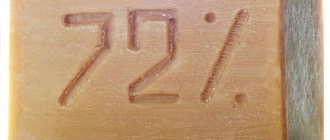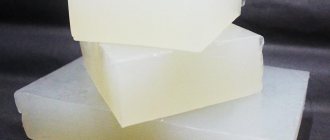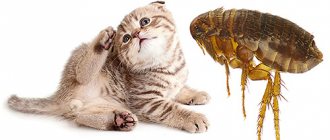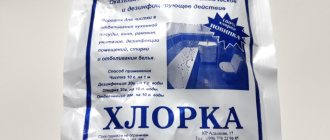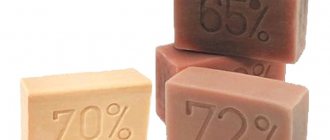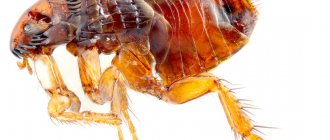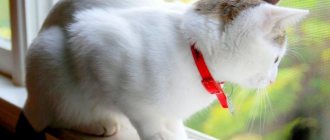At the moment, many owners of pets that have dog or cat fleas use tar soap. It consists of birch tar, which has many different healing properties.
Below, the article details how and on which flea-infested animals you can use tar and other insecticidal soaps.
Tar soap
What is the positive effect of tar soap?
This product has a specific color and also emits a sharp, unpleasant odor. Therefore, many parasites cannot tolerate such a soapy aroma.
As a result, many owners of cats or dogs, when using regular tar soap against fleas Ctenocephalides canis or Ctenocephalides felis, instantly and permanently destroy the larvae and eggs of such parasites on the fur of their pets.
In cats
Tar soap against fleas on cats quickly kills these parasites (Ctenocephalides felis) on such animals.
When using it, the cat owner performs the following steps:
- pre-foams the soap or soaks the soap bar in water. If the pet owner uses liquid soap, then this 1st point from the rules for bathing cats can be skipped;
- thoroughly wets the cat's fur;
- gently soaps the cat. In this case, the foam should not get into the ears, eyes and mouth of the animal, otherwise these external organs will be irritated and inflamed;
- then the pet owner does not wash off the foam, but wraps the cat in an old, unnecessary towel and holds it in it for 5–7 minutes;
- thoroughly rinses the cat's fur with water and then wipes it;
- Gently combs the cat - removes small pests and their eggs.
If a pet has a lot of similar parasites after being bitten by Ctenocephalides felis fleas, then after the first soaping the cat owner washes off the foam along with a large number of these small pests.
Next, the owners wash the cat’s fur with tar soap one more time and leave the foam on it for 5–7 minutes.
The pet owner performs this procedure once every 2-3 days, until all parasites disappear from the cat.
It is better to carry out such treatment of an infected cat or dog together, because the cat usually does not like such bathing. Indeed, in such a situation, this animal tries to quickly escape from the bath.
In kittens
When removing fleas from domestic kittens, their owners also use tar soap, but only in much more gentle versions.
Most manufacturers of such insecticides produce specific lines of products for fleas and for kittens.
Moreover, you cannot remove these parasites even with the help of tar soap on a kitten that is not yet 1 month old.
After all, a cat at this age has a weak immune system, and under the influence of an insecticidal soap, he can quickly become poisoned and die.
Thus, when ridding an infected kitten of Ctenocephalides felis fleas, its owner performs the following actions:
- combs the kitten with a fine-toothed comb. In this case, small pests, as well as their larvae, get stuck between the ridge teeth;
- exchanges for a new one and washes the kitten’s old sleeping mat (bed);
- Thoroughly vacuums the room in which fleas have infested.
Thus, the owner of a pet cat carries out the above manipulations every day.
Even if he does not completely rid the kitten of Ctenocephalides felis fleas, he at least waits until the small animal matures and can be treated with tar or other insecticidal anti-flea soap.
In dogs
With domestic dogs the situation is much simpler, because they are not afraid of water. When soaping a pet with tar soap, its owner kills the eggs of the Ctenocephalides canis fleas or the parasites themselves.
In this case, the dog owner performs the following actions:
- wets dog hair;
- foams tar soap for dogs in warm water until a large volume of foam solution is obtained;
- rubs soap suds on dog hair. In this case, the soap solution should not get into the dog’s nose, eyes, mouth and ears;
- waits a few minutes, and then thoroughly rinses the foam from the animal.
If the dog has thick, long hair, then its owner lathers the dog’s hair again with Ctenocephalides canis flea soap and waits a few minutes, after which he washes the foam off the dog.
If your pet dog has thin, dry skin, then you should wash it with anti-flea soap for dogs with extreme caution.
So, you can lather dog hair with dust soap only once in a few weeks, and with tar (or household soap) - several times in a few days.
In puppies
You can treat pet fur with tar soap against fleas not only on adult dogs, but also on their puppies. After all, such a product has a large number of different useful properties that help kill such small pests.
As a result, treating a puppy's fur with tar soap is safe. The procedure for this treatment is similar to that which the pet owner performs when washing an adult dog.
However, if the puppy is less than 1 month old, then you should not wash it with this soap either.
Also, before carrying out such a water procedure, the dog owner must stuff its ears with cotton balls. They will protect against water and foam.
Before bathing the animal, the corners of the eyes should be lubricated with Vaseline.
Reviews
Svetlana Vasilievna, 46 years old, Moscow:
“At the dacha, the cat picked up shingles somewhere. Due to the lack of opportunity to go to the city, i.e. to a veterinary pharmacy, I had to turn to traditional medicine methods. Apply tar soap foam to the affected area, rub in, and then wash off.
Additionally, after each soaping, I treated it with iodine. In this way, we managed to cure lichen in a week.”
Ivan Markovich, 77 years old, Novosibirsk:
“There were always cats at home, 2-3 each. Therefore, I had to deal with the problem of fleas more than once. When signs of parasites were noticed in one of the pets, everyone was immediately bathed with tar soap.
Now there is one cat living at home, which has access to the street. I also bathe her periodically with tar, but this time with shampoo, because... it is more convenient to use. A positive result is always visible after 1-2 procedures.”
Marina Sergeevna, veterinarian, Petro.
Will this soap help?
Does tar soap help get rid of Ctenocephalides canis or Ctenocephalides felis fleas?
Yes, this insecticide instantly and permanently kills fleas on the fur of a cat or dog. With the help of such a product, the pet owner completely destroys all parasites.
However, such treatment of an animal is a labor-intensive process. Ideally, tar soap should sit on dog or cat hair for about 30–40 minutes. with each application to destroy all parasites, but you can reduce this time to 10 minutes.
Composition and beneficial properties
Tar soap has a variety of insecticidal and medicinal properties.
This product consists of the following components:
- birch tar. Birch tar is very toxic to fleas Ctenocephalides canis, Ctenocephalides felis or other parasites. Also, such tar is a good antiseptic that slows down and stops the growth of various bacteria or fungi;
- phenol, cresol and alkali. These chemicals, which are part of the soap, leave various chemical burns on the body of fleas, from which they then die;
- sodium salts, which maintain salt and water balance in the skin.
It is also beneficial to use tar soap when ridding your pet of Ctenocephalides canis or Ctenocephalides felis fleas for the following reasons:
- small price - 20 rubles. for 1 piece At the same time, specialized various products for certain types of fleas cost 10 or more times more;
- such soap is safe for both pets and their owners;
- it does not cause allergies with frequent use.
Is it suitable for cats?
In addition to special shampoos intended for hair and skin care, there are drugs whose action is aimed at destroying parasites or fungus. Many cat owners refuse pharmaceutical products, preferring tar soap, because... this product has a number of useful properties.
When used correctly, this soap accelerates the process of cell regeneration and relieves irritation of the epidermis. It has anti-inflammatory and antibacterial effects. The smell of a hygiene product can repel parasites, which serves as a prevention of flea infestation.
But tar soap cannot be used regularly for the procedure either. The choice in favor of this product should be made if there is no special means for washing the animal at home.
Comparative characteristics
Many pet owners have 1 of 2 types of soap in their home - laundry or tar. Fleas Ctenocephalides canis or Ctenocephalides felis are also well killed by such products as dust and green soap.
Such insecticidal products are also inexpensive, have various beneficial properties and instantly destroy various parasites on dog or cat fur.
What soap should you use to wash your dog or cat? A detailed answer to this question is given below.
Degtyarnoe
Tar soap is considered a cosmetic cleanser, which is most often used when fighting cat or dog fleas (Ctenocephalides felis or Ctenocephalides canis). This product repels dog and cat fleas with its disgusting, pungent odor.
Tar soap has the following advantages:
- is a product made from natural raw materials, which is filled with birch tar;
- disinfects and also calms the animal;
- has low cost.
Economic
Laundry soap quickly cleans surfaces from various dirty stains and also destroys various microbes.
Such an insecticidal agent has the following advantages:
- is an environmentally friendly and hypoallergenic product;
- has a high alkaline balance;
- quickly destroys various microbes;
- has a low price.
Is it possible to completely remove Ctenocephalides canis or Ctenocephalides felis fleas using this product? No, because flea soap does not kill these parasites in cats or dogs at all, but only scares them away.
As a result, after using such a product, small pests leave the pet’s body and begin to jump around the bathroom or on clothes. In this case, they must be killed quickly before they spread throughout the apartment.
Dustovoe
Dust soap quickly and permanently destroys lice, various fleas or other similar insects. If laundry or tar soap is used at least 2 times, then it is enough to use dust soap 1 time to get the desired result.
However, doctors prohibit a person from frequently using such an insecticidal agent, because it gradually accumulates in the body of a cat, dog or person, which leads to its intoxication.
Will tar soap help against fleas? Yes.
The effectiveness of the product in the fight against fleas Ctenocephalides canis and Ctenocephalides felis is as follows:
- with a single use, it quickly calms the animal;
- damages the shells of flea eggs and then kills them;
- has a low cost.
At the same time, such a tool has several of the following disadvantages:
- very toxic;
- when accumulated in a human or animal body, it seriously disrupts the functioning of various organs;
- dangerous for children (both human and animal).
Green
Green soap for fleas Ctenocephalides canis and Ctenocephalides felis is an insecticidal preparation that is safe for humans and plants and effectively destroys these pests.
Such a tool has the following advantages:
- is an independent preparation that is used together with specific other insecticides, various bactericides or fungicides;
- does not harm the health of animals or humans;
- forms a film on the skin of 1 flea that blocks the flow of oxygen into the body of this parasite, as well as into its larvae and eggs.
Safety of use
- If there are signs of an allergic reaction, both in animals and humans, stop using the drug immediately.
- Disinfection is not recommended for women expecting babies. Sensitivity to any of the components may cause nausea and vomiting.
- The room where anti-flea therapy is carried out must be ventilated. Since the smell remains on the wool for 24-48 hours, it is necessary to maintain air circulation to avoid headaches, dizziness, and disorientation in space.
If you find fleas on your pet, you should not rush to buy newfangled drops, powder or sprays. Drug intervention is not always justified. Proper use of tar soap will help your pets recover from illness in a simple and painless way.
Rules for using tar soap against fleas
In order to quickly get rid of fleas in your apartment and on your pet using tar soap, you must use it strictly according to the instructions, without changing its specific method of use.
When using such an insecticidal agent, the owner of the dog or cat performs the following actions:
- puts the dog or cat in the bathtub. At the same time, the pet owner fills it with warm water in advance;
- thoroughly wets dog or cat hair;
- foams tar soap, and then applies soap foam to the wool. At the same time, the owner of the animal makes small massage movements over the fur of the cat or dog;
- carefully treats the belly, paws and withers of a cat or dog. Also carefully treat the animal’s face, because after soaping an infected animal, fleas Ctenocephalides canis or Ctenocephalides felis immediately crawl into this place;
- rinses off, and then applies foam for 10 minutes, while wrapping the cat or dog in a towel;
- Thoroughly washes dog or cat hair with warm water. In this case, you need to be careful, because surviving fleas quickly scatter during such a procedure;
- wipes and dries the fur, after which, with a fine comb, removes dead fleas Ctenocephalides canis and Ctenocephalides felis from it;
- if necessary, repeat a similar procedure after 3–5 days.
It is easier for dog owners to carry out a similar procedure, because dogs can tolerate regular bathing normally and without hassle. In such a situation, they are more patient and flexible animals than cats.
After washing a cat or dog against fleas with tar soap, their fur (especially cats) smells like tar for another 2-3 days. This smell will repel all types of similar small pests.
Therefore, during these 2-3 days, the pet owner carries out disinfestation in his apartment and thereby completely removes all such parasites from his home.
Is it effective against lichen?
Tar reduces the activity of bacterial and fungal microflora, so soap containing this element can be used to treat lichen in cats. To cure an animal, apply foam to the affected area and leave for 15 minutes.
You can also make pasta. You will need to rub the bar, fill it with warm water, and then wait until the crushed particles are completely dissolved. You should get a homogeneous mass. It is applied daily to the lichen, and after 15-20 minutes it is washed off with water.
Contraindications
In addition to the advantages described above, tar soap against fleas Ctenocephalides canis and Ctenocephalides felis has several disadvantages. So, this remedy sometimes causes allergies on the skin, so it is contraindicated for allergy sufferers, as well as for pregnant girls and women.
In addition, tar soap dries out the thin skin of people and animals. As a result, in humans or cats or dogs with thin skin, irritation develops, and small open cracks appear.
It must be borne in mind that animals have a more sensitive sense of smell than humans. Therefore, they also cannot stand the smell of tar soap.
As a result, a pet owner should not leave soap foam on dog or cat hair for a very long time - this should be done for no more than 10 minutes.
Advantages and disadvantages
The main advantages of tar soap over other drugs:
- safe (for pets and people);
- gives good results;
- can be used for kittens;
- inexpensive;
- can be used frequently;
- does not dry out the skin;
- allowed for use on existing wounds or scratches on the skin;
- does not contain aggressive chemicals or fragrances.
Flaws:
- pungent specific odor;
- re-processing required;
- the procedure is unpleasant for animals (most often cats do not like to bathe).
Precautionary measures
When using insecticidal tar soap, the owner of a cat or dog observes the following precautions:
- make sure that flea soap does not accidentally get into the eyes of a cat or dog;
- treats an infected pet only in the bathroom, without closing the door to this room;
- Do not wash your pet again if it has an allergy to a particular flea soap. In such a situation, the owner of the cat or dog, together with the veterinarian, selects another means to remove such parasites.
It is better for allergy sufferers not to carry out such treatment on their cats and dogs themselves, but to entrust this matter to their relatives or use tar soap for animals without a specific unpleasant aroma.
Failure to comply with such rules leads to the formation of severe allergies.
How the product works
The whole secret of the effective action of tar soap lies in its inherent smell, which repels small insects that cause considerable discomfort to four-legged pets.
This remedy can drive away mature individuals and eliminate their larvae. The resinous product found in soap, tar, leads to the death of microorganisms and pathogenic fungi.
Insects cannot tolerate tar odors, which lead to paralysis of the nerve impulse centers of parasites and the cessation of their vital functions.
The secret of the effective action of tar soap lies in its smell.
Which soap is better - liquid or solid?
Now on store shelves you can find liquid tar soap in pieces. Each release form has its own advantages and disadvantages, so it is difficult to say which is better. Hard pieces are more common. They contain only natural ingredients, but the disadvantage is that they are inconvenient to use. They don't lather well, so they need to be soaked and prepared in advance.
Soap liquid containing tar has the same properties and effects. It is convenient to use (just press the pump once or several times), but often contains surfactants (surface active substances). They dry out the skin excessively, which is especially noticeable with frequent use.
You can now see the current price of soap and buy it right here from Yandex Market with fast delivery:
Is it safe?
Tar soap is considered a relatively safe and non-toxic product for cats. Besides, it's cheap. Thus, in comparison with expensive chemicals that act as killers on fleas, tar soap is very advantageous if the cat does not have an individual intolerance to the components.
That is why the use of tar soap is allowed even for kittens 5-7 weeks old, although toxic drops and sprays are prohibited for them.
Unlike many flea products, tar soap does not dry out the skin. However, after it the wool becomes coarse.


